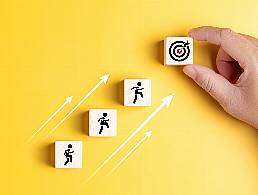As we reach one year of working from home in Ireland, Goodpath’s Bill Gianoukos shares his tips for getting the most out of your at-home work set-up.
For most people in Ireland, today (12 March) marks one year of working from home due to the pandemic. We’ve looked at adjusting and improving how we work remotely many times over the past 12 months, including the tools that can help us stay productive, how to take care of our mental health, how to lead in the new era of work and even what to watch on Netflix to wind down at the end of the day.
But what about your at-home work set-up? Has your company provided you with the equipment you need to carry out your duties comfortably? Are you putting unnecessary strain on your back or getting ‘tech neck’?
We spoke to Bill Gianoukos, CEO and co-founder of health consulting firm Goodpath. A serial entrepreneur and tech leader, Gianoukos works with co-founder Dr Akl Fahed, who is a cardiologist and scientist at Massachusetts General Hospital and Harvard Medical School, to progress integrative healthcare in the US.
He gave us some practical tips to keep in mind as we continue to work remotely for the foreseeable future.
‘An ergonomic set-up doesn’t have to be expensive or time-consuming – a lot of times one can use items lying around in the house’
– BILL GIANOUKOS
Do you think people are making mistakes when it comes to their home set-ups?
People have been working from home at an unprecedented level because of the pandemic. We’re seeing a surge of people complaining of various aches and pains because their home set-ups aren’t as ergonomically sound as what exists in an office environment.
Take something as simple as where and how people are sitting. While an ergonomic chair would be great, many people are sitting in a kitchen chair, on couches, even in bed. Those options make it easier for the body to be poorly positioned and cause challenges.
When chairs aren’t properly fitted to the person, the risk of musculoskeletal pain increases. For instance, if your chair is too low, it can cause you to slouch which puts stress on your low-back muscles. If you have armrests that are too high, you might start tensing your upper back.
What are the most common mistakes you’ve seen?
Saying someone has poor posture these days is a bit of a cliché but it is very prevalent, particularly as people make their own workspaces at home. In addition to how and where people sit, at Goodpath we also see members with musculoskeletal pain for different reasons.
Laptops weren’t created for long hours on end, they were intended to be mobile. Instead of looking straight ahead with good posture, [users] are constantly looking down, which can lead to neck pain, sometimes known as ‘tech neck’. Where possible, people should use external monitors to maintain proper alignment.
Image: Goodpath
Another common mistake is putting two computer screens next to each other at an angle. This causes one to turn the neck to one side or the other to look at either screen.
Our physical therapists also see right-hand-dominant workers unknowingly set up a workspace that would be better suited for a left-handed employee. If someone is constantly reaching across the body to reach for papers, the phone or using the printer, it can lead to shoulder pain or, worse, thoracic outlet syndrome.
What are the most important things to include in a good WFH set-up, in your opinion?
Our medical team and coaches do ergonomic assessments for our members with musculoskeletal pain.
Things that are often recommended in these assessments are having an external monitor, separate from a laptop screen, so your gaze is ahead of you, and an external keyboard so one’s hand and wrist placement isn’t causing forearm or wrist issues, such as carpal tunnel syndrome.
If an external monitor isn’t an option, one can prop up a laptop on several books or boxes, then use an external keyboard and mouse.
We also recommend creating workspace areas and designating primary versus secondary spaces. People should try to keep what is used most commonly within the primary workspace, which we define as within arm’s reach while maintaining elbows bent at a right angle.
The other thing to remember is that factors outside of the actual workspace can affect a person’s pain. Stress levels have risen with this pandemic and stress has a way of increasing pain. This can add to musculoskeletal pain from a poor WFH set-up. Using mind-body techniques like progressive relaxation and yoga can help people manage stress, anxiety and pain.
Do people need to invest a lot of time and money to get their WFH set-up right?
Not at all. An ergonomic set-up doesn’t have to be expensive or time-consuming. In fact, a lot of times one can use items lying around in the house.
Image: Goodpath
For instance, if a chair is too high and one’s feet aren’t touching the floor, put a short stool underneath the feet so that hips and knees are level. A stool isn’t available? Flip over a small trash bin or use a couple of old Amazon boxes.
Image: Goodpath
If one doesn’t have a desk, use the dining room table or kitchen island as opposed to the couch. Prefer to stand? Set up a few boxes on top of a dresser or high table and use a laptop there.
What advice would you give to people working from home at the moment?
Remember to care for the whole person. Think about how stress, one’s environment and a poor work-from-home environment can all contribute to pain.
I can tell you that I try to practise exactly what our medical team preaches:
- I keep to a routine. I have a specific workspace and I go there each day at roughly the same time
- I’m lucky to have a room for an office and have it set up with an eye-level-height monitor
- I take micro-breaks and get up to walk around the office every 30 to 60 minutes
- Sometimes I do some simple stretches while on a Zoom call
- I take walks when the weather is nice




